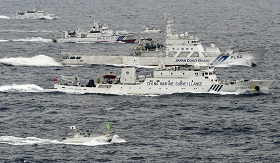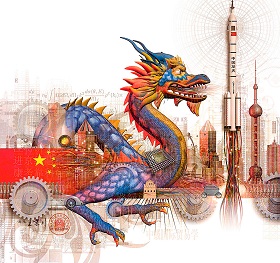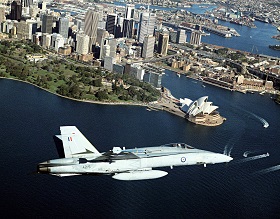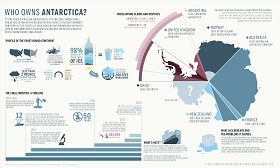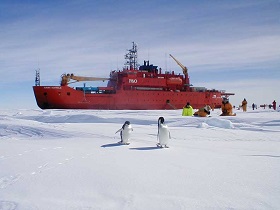Australia badly requires unlimited access to the World Ocean and its resources, its national security fundamentally hinging on maritime trading. Canberra's interests stretch far beyond the South Pacific. Moreover, the regional balance of forces is changing, compelling the country to modernize its defense capabilities, as well the strategy and tactics for deployment.
Clear and Present Dangers to the Green Continent
In July 2014, Canberra released a Defense Issues Paper outlining the contours of its strategy for military security prior to publication of the 2015 Defense White Paper. In the foreword, Australian Defense Minister David Johnston pointed out that the White Paper presented a new defense strategy, whose key points will be discussed in advance by the expert community. The list includes challenges and threats to the country's security and strategic interests, the objectives held by national forces for handling emerging challenges, relations with other countries and international organizations within and beyond the region, and major guidelines for financing security activities.
The Defense Issues Paper explains the need for the new defense strategy by the swift transformation of the Asia-Pacific region. The government is ready to raise military spending to two percent of GDP in as little as three years, finally topping AUD 32 billion (currently AUD 27 billion, i.e. 1.8 percent of the GDP). The two-percent figure will be maintained at least until 2024, ostensibly exceeding AUD 40 billion by that date. The Australian armed forces are developing their mission to maintain the country's security in case of aggression or the threat of aggression. With no direct indication of the source of the threat given, the document only states that the strategic environment in Asia-Pacific is subject to swift and unpredictable changes and points to several transnational challenges including the global spread of Islamic terrorism and rising tensions in intergovernmental relationships that are defining the structure of its military forces.
The Australian military underlines its unalterable alliance with the United States which is meant to defend the country on the international level, while Canberra will concentrate on the protection of sea lanes and cyberspace, as well as the fight against transnational crime, smuggling and illegal fisheries.
Australia's current geopolitical setting raises several questions. Does the Asia-Pacific area run the risk of a full-fledged military conflict? What are Australia's chances of becoming involved? What steps could the country take to strengthen regional peace and security and what operations could it undertake in the near future? Pundits have repeatedly stressed that the strategic milieu in Asia-Pacific is aggravating, with more and more countries acquiring the economic and defense capabilities sufficient for advancing their national interests, exemplifying the growing role of force in international relations by the "Russian annexation of Crimea", disputes over islands in the South China Sea and East China Sea, and the nuclear status of North Korea.
Middle Range Power – Liberalism or Realism?
In reality, Australia is developing its defense strategy based on the concept of a middle range power, the rank assigned to the country by some political scientists. Although liberal thinkers refrain from mentioning the role of force in the foreign policy of a middle range power, the Defense Issues Paper links Australia's new status with greater interest in matters outside the region, covering South Asia, East Africa and the Middle East, as well as its intention to significantly expand its military capabilities, among other things, in order to participate in conventional conflicts.
The Australian military defines its immediate neighborhood as Indonesia, Papua New Guinea, New Zealand and the South Pacific, where they plan humanitarian and disaster cleanup operations and, possibly, peacemaking missions. Canberra intends to conduct operations on its own, whereas it will operate in other regions within coalitions or jointly with the United States. Soon, the Australians are going to establish an up to 3,000-men-strong rapid deployment brigade for prompt responses to military-political and natural crises in its immediate neighborhood, with a reservation for possible expansion of that geography space.
Under these circumstances, Australia soon will face a difficult strategic choice between its alliance with the United States and economic cooperation with China. The document stresses that since 1972, when diplomatic relations were established between the two states, Canberra's ties with Beijing have advanced in a productive manner to a great extent defined by the climate of the U.S.-China interaction. The paper is not specific about the advantages of the American alliance, just mentioning access to intelligence and high technology, while Australia is will continue cooperating within the 5-Eyes informal arrangement for exchanging signals intelligence. Currently, the scheme incorporates the United States, Great Britain, New Zealand, Canada and Australia, with plans to include Malaysia and Singapore for better coverage of the Indo-Pacific region. The list of possible partners for security cooperation also includes the Philippines, Thailand, Vietnam and Myanmar.
As far as China is concerned, the paper emphasizes the need for military-to-military contacts, primarily for search-and-rescue operations at sea and assistance during natural disasters. Japan has been given the role of a key technology partner, while the Republic of Korea is mentioned only occasionally. Canberra finds it practical to promote multilateral security cooperation formats like ASEAN plus the 3 Meeting of Defense Ministers, ASEAN Regional Forum and Indian Ocean Naval Symposium.
Canberra is deeply worried about China, which is reflected in the government documents, while some experts are even considering scenarios for countering Chinese fighter jets in the region. A new anti-Beijing wave arose in February 2014, when a Chinese flotilla sailed around the island of Java close to the Australian Christmas Island and held an exercise there. Military analysts came to the conclusion that China would continue to operate around Australia, since these waters hold commercial sea lanes and hold offshore hydrocarbon reserves important for Beijing.
The Australians are also concerned about the future settlement of the Japan-China dispute over the Diaoyudao/Senkaku Islands and the multilateral conflict in the South China Sea, with the situation aggravated by the Chinese Navy's outward intention to weaken U.S. positions in the region. Bearing in mind expanded U.S.-Australian defense cooperation, these events are generating strategic uncertainty about American military facilities on the Green Continent. Canberra cannot but fret about Beijing's intense interest in the Indian Ocean, because the trend is fraught with stronger China-India differences and more frequent use by the Chinese Navy of the Lombok and Sunda Straits, an alternative to the overburdened Malacca Strait.
Rearmament for the "White Majority"
The 2014 Defense Issues Paper pays much attention to developing Australia's defense industry with the focus on reaping budget savings and improving the armed forces' technology level and overall capabilities. The government would like to make the defense sector fully competitive with preference given to local manufacturers and a focus on advancing commercial and naval shipbuilding as a springboard for national economic growth.
According to a Lowy Institute poll, 83 percent of Australians consider the military forces as a very important foreign policy instrument, while 15 percent see it as simply important. However, Canberra has yet to make a strategic decision on a sensible defense spending ceiling. Today, defense consumes seven percent of the national budget, the fourth largest item after social security and welfare, healthcare and education. Quite fascinating is the rationale whereby higher defense spending can be made possible only if the Celtic and Saxon population overwhelmingly dominates. If the share of migrants and their influence on socio-political processes increase, the defense budget will be cut in order to bolster socially significant expenditures.
Australian military experts stress that the Navy must remain a credible and flexible force able to contain and defeat an enemy if the need arises. The priority list includes the Hobart-class destroyers (the first one is to be commissioned in 2016), the Canberra-class all-purpose landing ship (to be commissioned soon), LCM1E landing craft, and possibly stealthy diesel submarines based on world-class designs.
The Army has been tasked to deter and eliminate threats to Australia's sovereignty. Due to the relatively small population and low probability of a war on the continent, the peacetime strength of the Army is held under 30,000, its combat component including three brigades, three special operations regiments, one marines battalion, as well as army aviation, the UAV, reconnaissance and logistics regiments. The armored forces are made up of 59 Abrams tanks, about 680 armored personnel carriers and 740 armored vehicles. The Army is equipped with 22 Tiger attack helicopters, 34 Blackhawk multirole helicopters and other vehicles, as well as missile launchers, towed howitzers and mortars.
The tasks set forth for the Air Force include defending from maritime and air attacks, protecting of sea lanes, projecting force in South Pacific, and participating in international operations for maintaining global security and stability. The air fleet is based on the F-18 platform, while the new items include the Poseidon maritime surveillance aircraft, Wedgetail early warning and control aircraft, and Spartan battlefield airlift. Australia is also considering purchasing multifunction F-35s that can be acquired up only by 2020. Some experts attribute the deployment of long-distance UAVs and AWACS aircraft to the higher military activity of China.
The Australian defense forces are engaged in 10 foreign operations, the largest in the Middle East (Accordion, Manitou) and in Afghanistan (Slipper).
Struggling for the Southernmost Place in the World
Australia's Antarctic policy is clearly very important for the entire region. Canberra prefers to overlook the issue in its defense policy papers, apparently because of the southern continent's special legal status. At the same time, Australia is aware of the fact that its nominal claims on 42 percent of the Antarctic territory are going to face fierce competition.
In October 2013, the Australian Strategic Policy Institute issued the paper "Cold Calculations: Australia’s Antarctic
Challenges" aimed at assessing the practicality of annual allocating at least AUD 112.8 million for its national Antarctic program. The paper describes Canberra's key objectives in the Antarctic as the retention of its sovereignty over the territory, avoiding confrontation and militarization, and the protection of the environment and economic gains.
The Antarctic is facing several challenges, including a clash of sovereignties, rising fisheries and tourism, the development of mineral resources, and increased interest from China. The Antarctic Treaty of 1959 provides for the exploitation of the continent for the good of all mankind, free scientific research, and the prohibition of military activities. Alongside Australia, territorial claims are coming from Argentina, Great Britain, New Zealand, Norway, France and Chile, while Peru, Russia, the U.S.A. and South Africa reserve similar rights. The growing potential of states will ostensibly increase their Antarctic ambitions, especially in the eastern sector, which makes life for Australia more difficult. The document names Russia and China, who are stepping up research in the region there, as the frontrunners in the quest for a reshaping of the Antarctic, with considerable interest also displayed by South Korea and India.
It is difficult to claim Antarctic leadership with a single ice-class vessel, so Canberra must augment its shipbuilding programs with commercial vessels and patrol ships suitable for the Southern Ocean. Because of this, one cannot exclude deeper cooperation with European countries, which may offer technological and financial assistance, as well as physical protection, in exchange for preferences.
Although Australian defense policy papers have never mentioned the Antarctic directly, their certain provisions still cover the world's southernmost territory. For example, the 1987 White Paper laid out the country's readiness to defend the Antarctic's demilitarized status. The Report "Defending Australia in the Asian-Pacific Century: Force 2030" specified the need to protect the sovereignty of certain islands and water areas in the Antarctic zone, as well as potential challenges that may require a military response.
It also is appropriate to cite the initiative of Australian Environment Minister Greg Hunt, who has established a government coalition for a 20-year strategic plan to organize large-scale research in the Antarctic and the Southern Ocean. The proposal includes such key points as ensuring reliable access to Australia's Antarctic territories through an expansion of the controlled zone, exerting stronger influence on the Antarctic Treaty, and obtaining a special status for Tasmania as a springboard for Antarctic research and development.
* * *
Widely discussed in Australia, the 2015 White Paper will contain specific proposals to ensure military security in the southern parts of the Pacific and Indian oceans, as well as sovereignty in the Antarctic. We are sure to witness the advancement of Canberra's policies along the middle range power guidelines, which should mean the expansion of geographical influence as well as the range of tools to influence both partners and contenders. Australia's motives for enhancing its defense capabilities are not very convincing due to the absence of geopolitical rivals and major territorial disputes. In the role of another American unsinkable aircraft carrier, the Green Continent seems prone to even greater reputational damage and economic risks. Some time ago Australia used to be perceived as an originator of significant peace initiatives, while now it tends towards the primacy of military force, which can easily affect the already complicated Indo-Pacific region.
Russia boasts vast experience of cooperating with Australia in many areas, from nuclear energy to the Antarctic research. Moscow regards Canberra's participation in the anti-Russian sanctions as a sign of immaturity and its inability to carry out an independent and balanced foreign policy. With the desire to refrain from the issue of strategic choice, Australia will have to take sides, the choice being between subordination and authority rather between the United States and China.


